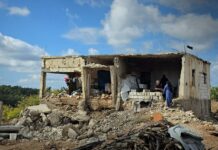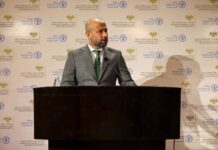
Wildfires have scorched over 14,000 hectares of forest and farmland in Syria’s northern Latakia countryside since July 2, displacing more than 1,100 people and affecting an excess of 60 communities. The fires, driven by high winds and intense heat, mark one of the most severe environmental disasters in the country’s recent history.
Syria’s Ministry of Emergency and Disaster Management said firefighting efforts have continued without pause for eight days. Civil Defense teams, supported by volunteers, ministries, and international partners, have fought to contain the flames and prevent their spread into populated areas.
Multi-Ministry Response and Civil Solidarity
Emergency and Civil Defense officials have coordinated across several ministries, with field operations overseen by the Ministry of Defense, the Interior Ministry and the Ministry of Social Affairs. Minister of Emergency and Disaster Management Raed al-Saleh announced the creation of a joint operations room to support response teams and deliver aid.
On the ground, over 80 Syrian Civil Defense units are active alongside firefighting aircraft and teams from Turkey, Jordan, Lebanon and Cyprus. Saleh expressed gratitude for regional cooperation, calling it “an example of brotherhood and joint responsibility.”
The Ministry of Social Affairs has launched assessments for potential compensation, and launched humanitarian efforts in coordination with local organizations. In Daraa, residents initiated the “March 18” campaign to support Civil Defense personnel, sending blankets, food, and water.
EU and UN Join Technical Support Effort
The EU has activated its Copernicus rapid mapping service following a request from Damascus. Satellite imagery is helping Syrian authorities assess damage and identify fire hotspots. The EU’s Chargé d’Affaires in Damascus, Michael Onmacht, reaffirmed Europe’s willingness to assist during a meeting with Syrian officials.
The UN Office for the Coordination of Humanitarian Affairs estimates the fires have destroyed 100 square kilometers of forest, or over three percent of Syria’s total forest cover. The agency also reported that at least seven towns have been evacuated as a precaution.
In Absence of Evidence Arson Speculation Lingers
Interior Minister Anas Khattab confirmed an investigation is underway into the fires’ origins. He acknowledged suspicions of arson but said no evidence has yet confirmed deliberate ignition. Security forces have increased patrols and established roadblocks in fire-hit areas.
Many believe former Assad regime remnants are responsible and a group calling itself Saraya Ansar al-Sunna claimed responsibility for the fires in an unverified statement, but no conclusive link has been established. Syrian officials have urged caution, citing the scale of the fires and the complex terrain as key factors in the blazes’ spread.
Recovery and Risk Still Ahead
As fires continue in scattered zones, Civil Defense teams are monitoring flare-ups in areas such as Kostel Maaf and Al-Baraka. Saleh said long-term plans include building permanent response centers and installing early-warning systems.
With no fatalities reported and only minor injuries among responders, officials credit the joint efforts of local and foreign teams for limiting human losses. Latakia Governor Muhammad Uthman announced a reforestation campaign, calling on residents to help “revive the land with our hands.”









